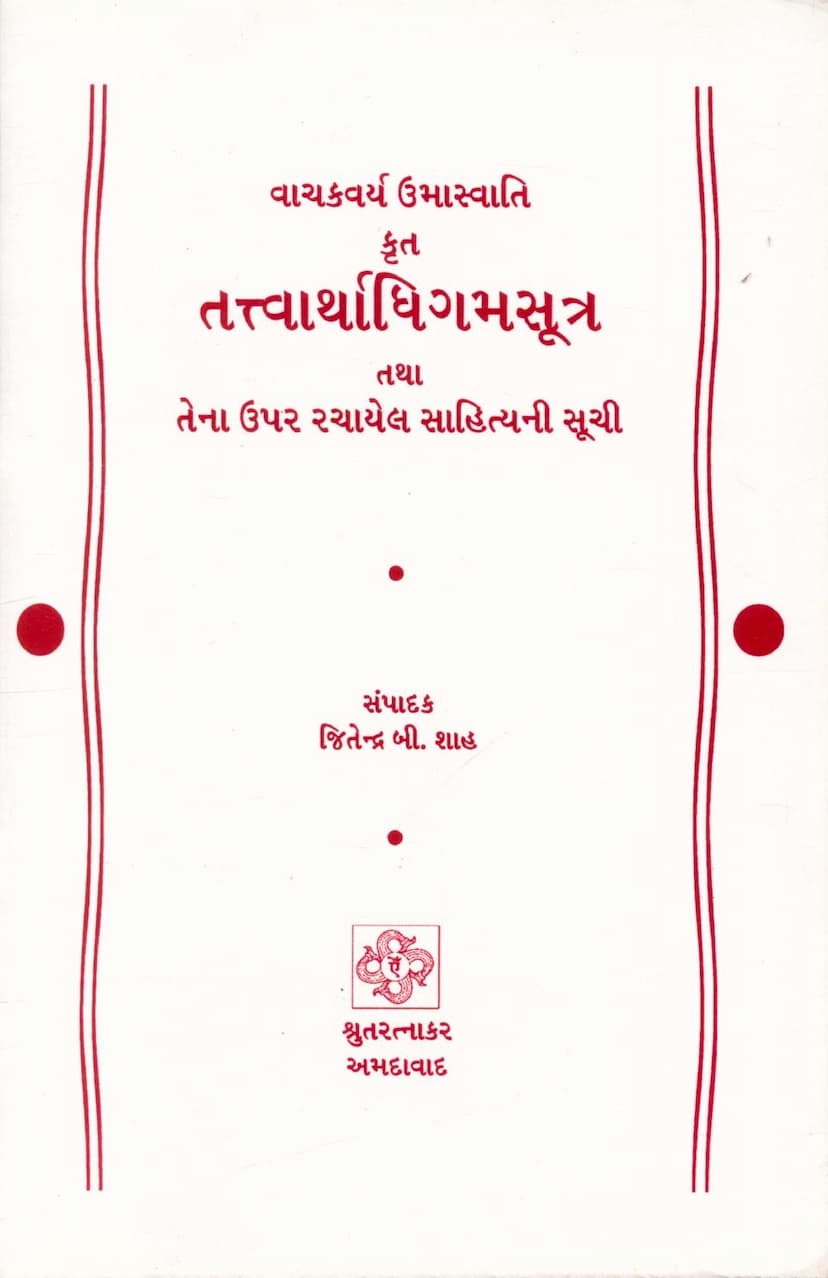Tattvarthadhigamsutra Tatha Tena Uper Rachayel Sahityani Suchi
Added to library: September 2, 2025

Summary
Here is a comprehensive summary of the Jain text "Tattvarthadhigamsutra tatha Tena Uper Rachayel Sahityani Suchi" by Jitendra B. Shah:
This book, published by Shrutratnakar in Ahmedabad, is a bibliography dedicated to the Tattvarthadhigama Sutra composed by Umasvati (or Umaswami), a highly revered figure in Jainism. The title translates to "Tattvarthadhigama Sutra and a List of Literature Composed Upon It."
Introduction (Bhumika):
The introduction emphasizes the profound significance of the Tattvarthadhigama Sutra. It states that this text, comprising only 344 sutras (aphorisms), encapsulates the essence of the entire Jain philosophy. Compared to the vast and complex 45 Jain Agamas (canonical texts), Umasvati's work is presented as an "ocean in a pot," a distillation of the Agamas' wisdom into a more accessible form.
A key point highlighted is the shift in language. While the original Agamas were in Ardhamagadhi Prakrit (the spoken language of the time of Lord Mahavir), which was not universally accepted by scholars, Umasvati chose to compose the Tattvarthadhigama Sutra in simple Sanskrit. This made it the first Jain text written in Sanskrit in a sutra style, thus gaining acceptance among a wider scholarly audience.
The Sutra covers essential Jain topics such as epistemology (Jnana Mimamsa), the nature of the soul (Jiva Mimamsa), cosmology (Loka Mimamsa), metaphysics (Tattva Mimamsa), and ethics/conduct (Achara Mimamsa). Its universal acceptance across all Jain traditions (Śvetāmbara, Digambara, Sthānakavāsi, and Terāpanthi) is attributed to Umasvati's skillful compilation. Some scholars suggest the text predates the major schisms within Jainism.
The introduction also touches upon the differing opinions regarding Umasvati's time of birth and life, noting that all traditions claim him. The presence of his own commentary (Bhasya) further illuminates many aspects of his work.
The bibliography then discusses the tradition of commentaries (vyakhya) that followed the original Sutra, noting two main traditions: the Śvetāmbara tradition, which follows the Bhasya, and the Digambara tradition, which interprets the Sutra in line with the principle of Anekāntavāda (non-absolutism).
The introduction concludes by highlighting the extensive literature, including translations and commentaries, that has been produced on the Tattvarthadhigama Sutra in various Indian and foreign languages over the past century. This prolific output underscores the Sutra's importance and makes this bibliography a valuable resource for students and scholars.
The Catalog:
The latter part of the provided text is a detailed catalog of publications related to the Tattvarthadhigama Sutra. It meticulously lists hundreds of publications, categorized by:
- Publication Year (Gregorian Calendar): Starting from 1880, this section lists numerous editions, translations (Hindi, Marathi, German, English, Gujarati, etc.), commentaries, and critical studies of the Tattvarthadhigama Sutra and its various commentaries. It cites specific publishers, editors, and sometimes the number of verses or scope of the work.
- Publication Year (Vikram Samvat): This section continues the list of publications with their corresponding dates in the Vikram Samvat calendar, further emphasizing the extensive engagement with the text.
- Publication Year (Shaka/Vir Samvat): This section lists publications based on the Shaka and Vir Samvat eras, demonstrating the long historical tradition of studying and commenting on the Sutra.
- Publications with Unknown Publication Year: Finally, it lists important publications where the year of publication is not specified.
Key Themes and Information from the Catalog:
- Vastness of Literature: The catalog clearly demonstrates that the Tattvarthadhigama Sutra is one of the most studied and commented-upon texts in Jainism, with over 300 published works listed.
- Multilingual Engagement: The Sutra has been translated and discussed in numerous languages, reflecting its broad appeal and the efforts to make its teachings accessible to a wider audience.
- Commentarial Traditions: The catalog implicitly showcases the different interpretations and analytical approaches from various traditions and scholars.
- Historical Significance: The chronological listing of publications provides a historical overview of the reception and study of the Tattvarthadhigama Sutra over centuries.
- Scholarly Debate: The mention of differing views on Umasvati's authorship and dating, as well as the existence of separate interpretations by Śvetāmbara and Digambara scholars, indicates ongoing scholarly discussion.
- Specific Commentaries Mentioned: The catalog highlights key commentaries like the Swopajña Bhasya (Umasvati's own commentary), Genda Hastibhasya, Sarvartha Siddhi (by Pujyapada), Laghu Vritti (by Haribhadra Suri), and Raja Vartika (by Akalankadeva), among many others.
In essence, this book serves as an exhaustive bibliographical resource for anyone interested in the Tattvarthadhigama Sutra, Umasvati, and the vast literary tradition that has grown around this foundational Jain text. It underscores the Sutra's central role in Jain philosophy and its enduring influence across different schools and languages.